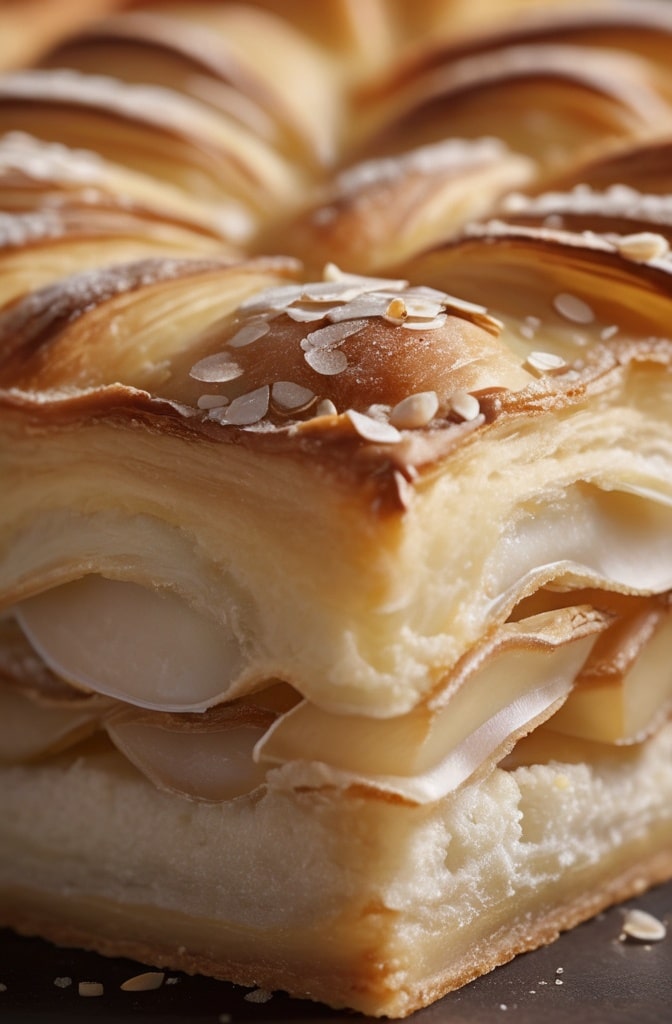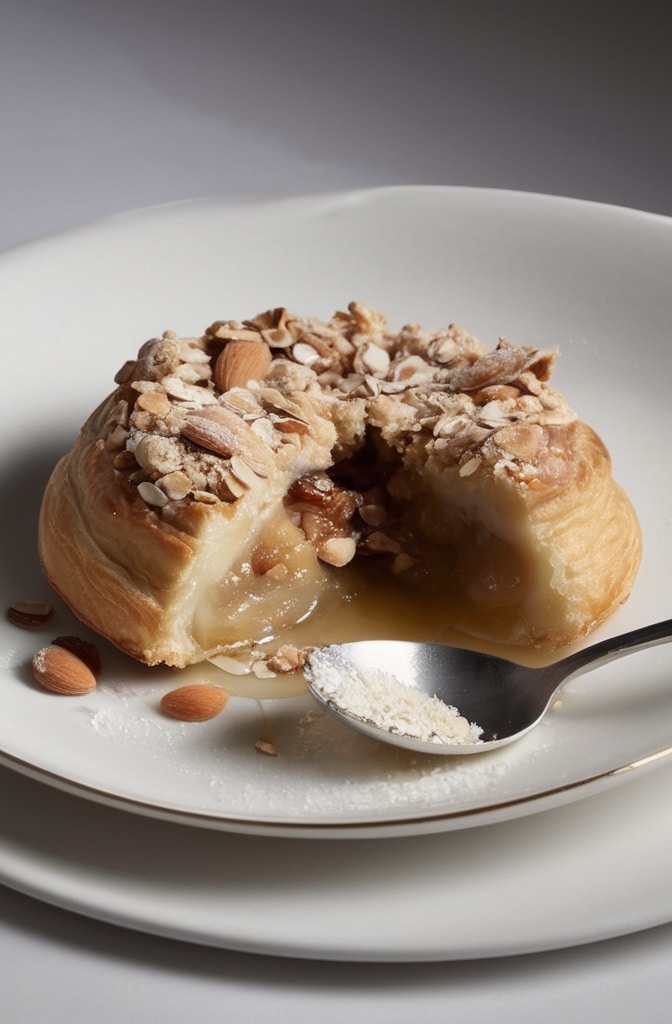The intoxicating aroma of almonds toasting in the oven transports me instantly to my grandmother’s kitchen in southern France, where I first fell in love with Sweet Almond Pastry Perfection. As a child, I would watch her hands weathered but precise—fold delicate layers of pastry while explaining that patience was the secret ingredient no recipe could list.
Sweet almond pastry occupies that rare culinary territory where simplistic ingredients transform through technique into something truly magnificent. Have you ever wondered why some bakers consistently achieve that perfect balance of flaky exterior and tender almond-rich interior?
Almond pastry, particularly the frangipane-filled varieties, represents a pinnacle of pastry craftsmanship that balances technical precision with artistic expression. This isn’t merely a recipe—it’s an exploration of centuries-old techniques refined by generations of pastry chefs who understood that temperature, timing, and touch create the difference between pedestrian baking and transcendent pastry.
The marriage of buttery layers with the complex nuttiness of almonds creates something greater than the sum of its parts.
1. Ingredients & Substitutions
For the Pastry Dough
- 250g all-purpose flour (preferably European-style with 10-11% protein content)
- 225g unsalted butter, chilled and cubed
- 1 tsp fine sea salt
- 30g granulated sugar
- 60-80ml ice-cold water
- 1 tbsp apple cider vinegar (helps inhibit gluten development for tenderness)
High-quality butter is non-negotiable here—look for European-style with at least 82% butterfat for that incomparable flavor and texture. Lower fat butters contain more water, which can lead to less defined layers and soggy bottoms (a cardinal sin in pastry circles). For those avoiding dairy, cultured vegan butter works suprisingly well, though the hydration may need minor adjusting.
Pastry flour would techinally be ideal for tenderness, but all-purpose with the vinegar addition achieves nearly identical results while being more accessible. Gluten-free bakers can substitute a 1:1 blend, but add 1/4 teaspoon xanthan gum and expect slightly less lamination in the final product.
For the Frangipane Filling
- 200g blanched almonds (or almond flour for convenience)
- 150g caster sugar
- 150g unsalted butter, softened
- 3 large eggs
- 30ml amaretto liqueur (optional but traditional)
- 1 tsp almond extract
- Zest of one unwashed organic lemon
- 30g all-purpose flour
- 1/4 tsp salt
Blanched almonds produce a smoother texture, but those with skins retain provide more robust flavor compounds—the choice depends on your preference for refinement versus rustic character. Those with nut allergies could substitute sunflower seed meal with a drop of bitter almond oil (used sparingly), though the flavor profile shifts noticeably.
Fresh eggs at room temperature incorporate more evenly and create a lighter texture. The amaretto deepens the almond flavor through complementary aromatics rather than simply intensifying it—a subtle but worthwhile distinction. If alcohol is a concern, orange blossom water makes an exceptional alternative.
For Finishing
- 1 egg, beaten with 1 tbsp water
- 50g sliced almonds
- 25g apricot jam, warmed and strained
- Confectioners’ sugar for dusting
2. Step-by-Step Instructions

Creating Perfect Pastry
- Combine flour, salt, and sugar in a food processor. Add cold butter cubes and pulse just until mixture resembles coarse crumbs with some pea-sized pieces remaining—overmixing here is the silent killer of flaky pastry.
- Transfer to a chilled bowl and sprinkle with vinegar and 60ml ice water. Using a fork, gently incorporate liquid until dough just begins to come together. If needed, add remaining water a teaspoon at a time—the dough should be neither crumbly nor sticky, but just cohesive enough to hold together when squeezed.
- Form dough into a rectangle (rather than traditional disc shape) to facilitate later rolling. Wrap tightly in reusable wax wrap or parchment and refrigerate for at least 2 hours or ideally overnight. This resting period allows flour to fully hydrate and gluten to relax, preventing the dreaded pastry shrinkage during baking.
The most common mistake bakers make is overworking the dough, developing too much gluten which results in tough rather than tender pastry. Keep everything cold—I even chill my flour and food processor blade before starting. For extra insurance against toughness, some chefs freeze the butter and grate it directly into the flour.
Simple Lamination Method
- On a lightly floured surface, roll chilled dough into a rectangle approximately 10×14 inches. Fold the bottom third up and the top third down (like a business letter), creating three layers. Rotate 90 degrees and repeat rolling and folding process. This simplified lamination creates distinct flaky layers without the complexity of traditional puff pastry.
- Wrap and refrigerate for 30 minutes. Repeat the rolling and folding process twice more for a total of three “turns.” After final turn, wrap tightly and chill at least 1 hour before using. For a quicker version that sacrifices some flakiness, a single turn will suffice in a pinch.
- Roll pastry to 1/8-inch thickness and line a 9-inch tart pan with removable bottom, leaving slight overhang. Trim excess and create decorative edges if desired. Dock bottom with fork and freeze for 15 minutes while preparing filling—this prevents shrinkage during baking.
Creating the Frangipane
- If using whole almonds, toast at 350°F (175°C) until fragrant (about 8 minutes), cool completely, then process in food processor until finely ground but not oily. For almond flour, toasting for 5 minutes still improves flavor considerably.
- Cream butter and sugar until pale and fluffy—about 3-4 minutes on medium-high speed. Don’t rush this step; proper aeration here creates that distinctive light yet rich texture that defines excellent frangipane.
- Add eggs one at a time, incorporating fully between additions. If mixture appears curdled, don’t panic—adding a tablespoon of the flour can restabilize the emulsion. Add amaretto, almond extract, and lemon zest, then fold in ground almonds, flour, and salt until just combined.
For variations, try substituting 50g of the almonds with pistachios or hazelnuts. Folding in 2 tablespoons of good raspberry preserves creates beautiful flavor contrast. For a more sophisticated adult version, macerate dried cherries in kirsch before folding them through the filling.
Assembly and Baking
- Spread frangipane evenly in chilled pastry shell. For classic almond tart, arrange fresh fruit like poached pears, plums, or berries on top. Alternatively, create a classic pattern with overlapping sliced almonds.
- Brush exposed pastry edges with egg wash and sprinkle with sliced almonds. Bake at 375°F (190°C) for 15 minutes, then reduce temperature to 350°F (175°C) and continue baking for 25-30 minutes until filling is puffed, set, and golden brown.
- Cool in pan for 15 minutes before removing sides. While still warm, brush fruit or top surface with warmed apricot jam for that professional sheen and flavor enhancement. Cool completely before dusting with confectioners’ sugar.
The tart should wobble very slightly in the center when done—similar to a properly baked cheesecake. Overbaking dries out the filling, while underbaking results in a doughy consistency rather than the desired creamy texture. Let the golden color of the filling guide you; deep amber indicates perfect caramelization of sugars.
3. Cooking Techniques & Science
The magic of almond pastry lies in its seemless integration of multiple baking techniques. The pastry utilizes the principles of lamination—creating alternating layers of dough and fat that, when exposed to high heat, create steam pockets as moisture evaporates. These pockets push the layers apart, creating that distinctive flaky texture.
Temperature control is absolutely critical. Cold butter remains solid until hitting the oven’s heat, where it quickly melts, releasing steam and creating separation between layers. If the butter warms prematurely during preparation, it absorbs into the flour rather than remaining discrete, resulting in a more cookie-like texture rather than flaky layers.

Frangipane represents a fascinating culinary intersection between cake batter and custard. The high fat content from both butter and almonds creates richness, while eggs provide structure through protein coagulation during baking. The small amount of flour stabilizes the mixture, preventing the separated, curdled texture that can plague nut-based fillings.
The Maillard reaction—that complex process where proteins and sugars transform under heat—is responsible for both the golden color and complex flavor compounds that develop during baking. This reaction accelerates at higher temperatures, which explains the initial hot oven followed by a temperature reduction to prevent burning while ensuring complete cooking.
Professional pastry chefs often use metal rings rather than ceramic tart pans for more consistent heat conductivity, resulting in crisper pastry bottoms. If using glass or ceramic bakeware, consider “blind baking” the shell for 10 minutes with weights before adding filling to prevent the dreaded soggy bottom phenomenon.
4. Serving & Pairing Suggestions
A properly executed almond pastry needs little adornment, but thoughtful presentation elevates the experience from merely delicious to memorable. Serve slightly warm (but not hot) to appreciate the contrast between the crisp exterior and tender filling. A light dusting of confectioners’ sugar applied just before serving prevents absorption and maintains visual appeal.
For plated desserts, consider accompanying with a quenelle of vanilla bean crème fraîche or a small pool of warm anglaise sauce infused with orange zest. The slight acidity balances the richness of the pastry beautifully. For textural contrast, a small scoop of toasted almond praline ice cream creates a hot-cold interplay that delights the palate.
Beverage pairings should complement rather than compete with the pastry’s nutty complexity. Vin Santo, Sauternes, or a well-aged Tawny Port create wonderful harmony with the almond notes. For non-alcoholic options, an Ethiopian Yirgacheffe coffee with natural notes of stone fruit and almonds makes a remarkable companion.
This pastry shines as the centerpiece of a afternoon tea service, particularly when cut into smaller rectangular portions. For brunch presentations, consider a deconstructed approach—individual tartlets accompanied by seasonal fruit compote and crème anglaise poured tableside.
Conclusion
Mastering sweet almond pastry represents a significant milestone in any baker’s journey. The techniques employed—from proper lamination to temperature control to the precise balance of fat, sugar, and aromatics—create a foundation applicable across countless pastry applications. What makes this particular preparation special is how it showcases the almond in multiple dimensions: the crunch of sliced almonds, the richness of frangipane, and the subtle fragrance that permeates the entire creation.
Don’t be discouraged if your first attempt falls short of perfection—even experienced pastry chefs acknowledge that environmental factors like humidity and flour protein content require constant small adjustments. The true mark of expertise isn’t avoiding mistakes but knowing how to compensate for them.
Remember that the distinction between good pastry and exceptional pastry often comes down to patience—allowing proper resting time between steps, maintaining temperature control throughout, and resisting the urge to rush the baking process. In our hurried culinary landscape, sweet almond pastry reminds us that some pleasures simply cannot be accelerated.
FAQs About Sweet Almond Pastry
Can I make the components ahead of time?
Absolutely! The pastry dough can be refrigerated for up to 3 days or frozen for 1 month. Frangipane keeps beautifully for 3 days in the refrigerator or up to 3 months frozen—just bring to room temperture before using. The fully assembled tart is best enjoyed within 24 hours but remains delicious (albeit with softening pastry) for up to 3 days when stored in a cool, dry place.
Why did my frangipane filling overflow during baking?
This typically occurs when the filling exceeds 3/4 of the pastry shell’s depth. Remember that frangipane rises significantly during baking due to the leavening effect of creamed butter and eggs. Fill shells no more than 2/3 full, and place the tart on a baking sheet lined with parchment to catch any potential overflow.
How can I prevent a soggy bottom on my tart?
Three techniques virtually guarantee crisp pastry: First, thoroughly dock (pierce) the pastry before baking. Second, freeze the shaped crust for 15 minutes before filling. Finally, consider blind baking the shell for 10 minutes at 375°F (190°C) with parchment and weights before adding the filling. A dark metal tart pan also promotes better browning than glass or ceramic alternatives.
What’s the difference between frangipane and marzipan?
Though both feature almonds prominently, they’re fundamentally different preparations. Frangipane is a baked almond cream with butter, eggs, and sugar—light and cake-like when baked. Marzipan is a dense, moldable paste of ground almonds and sugar used primarily for decorative work or confections. Frangipane contains a higher proportion of butter and eggs, creating its characteristic soft, tender texture when baked.
Can I use almond extract instead of amaretto?
Yes, but use restraint—almond extract is significantly more potent than amaretto liqueur. Start with just 1/4 teaspoon additional extract and adjust according to your preference. Alternatively, orange flower water (1-2 teaspoons) or Grand Marnier (2 tablespoons) make excellent substitutions that complement the almond flavor beautifully without overpowering it.

